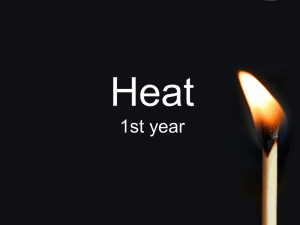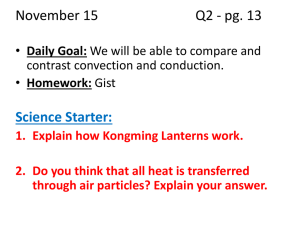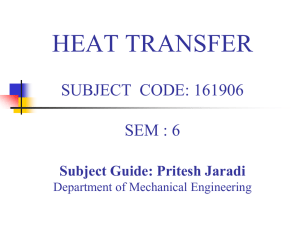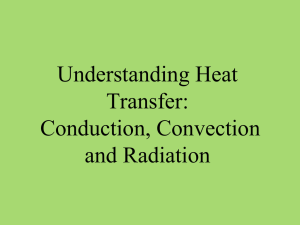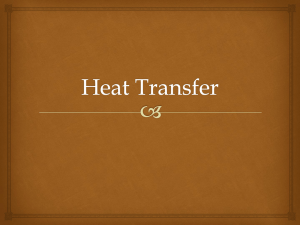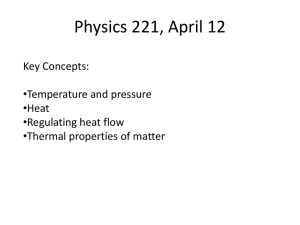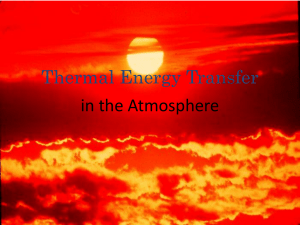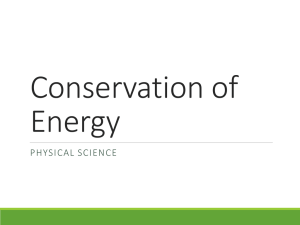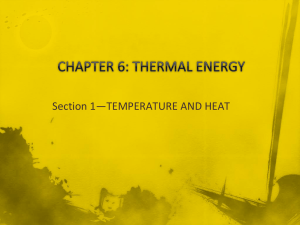fifth energy - christianacoburn
advertisement
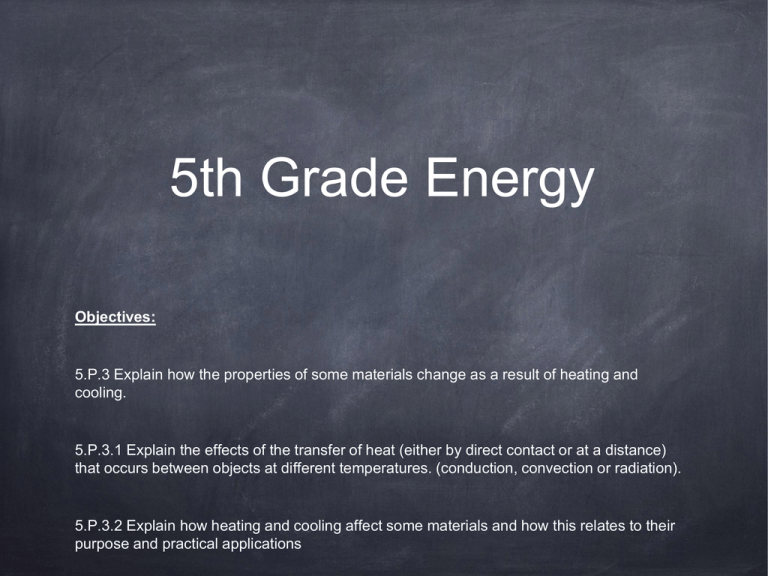
5th Grade Energy Objectives: 5.P.3 Explain how the properties of some materials change as a result of heating and cooling. 5.P.3.1 Explain the effects of the transfer of heat (either by direct contact or at a distance) that occurs between objects at different temperatures. (conduction, convection or radiation). 5.P.3.2 Explain how heating and cooling affect some materials and how this relates to their purpose and practical applications Vocabulary • • • • • • Energy: something that causes a change or creates motion Kinetic energy: the energy of any moving object (moving) Potential energy: stored energy (not moving) Conduction: the passing of heat through a material while the material itself stays in place Convection: the flow of heat through a liquid or a gas, causing hot parts to rise and cooler parts to sink Radiation: the transfer of heat through electromagnetic rays Types of energy • Human • Mechanical • Electrical • Electromagnetic • Chemical energy • Radiant energy • Thermal energy • Light producing • Non heat producing • Sound Heat Transfer Heat always moves from a warmer place to a cooler place. Hot objects in a cooler room will cool to room temperature.e.g: tea, coffee Cold objects in a warmer room will heat up to room temperature.e.g: butter, ice Heat can be converted to other forms of energy Heat is a form of energy created by the movement of molecules (substances change form when heated…solids, liquids, and gases) Sunlight (heat) is used by plants for Photosynthesis (to make food), it is converted to chemical energy. Oil and gas are burned in power stations to produce heat energy, this is used to turn turbines which produce electricity (electrical energy) What do you think? How does heat move? AKA… forms of heat transfer • • • Conduction: warming your hands on a coffee mug, cooking on a stove, and candy melting in your hands. Convection: weather convection cells or a pot of water being heated to boil (As the water heats at the bottom, the hot water rises and the cooler water at the top falls to the bottom which heats and rises thus causing a circular motion) Radiation: the sun warming your body, a campfire warming your body, or a light bulb causing heat. Radiation How does heat energy get from the Sun to the Earth? ? There are no particles between the Sun and the Earth so it MUST travel by radiation RADIATION Radiation The transfer of heat in rays, from a hot object, without needing a medium to pass through It travels in all directions from a hot object The hotter an object is, the more heat it will radiate out Does the surface affect the way heat is radiated? Which colour is better to wear on a sunny day? black or white? A dull black surface will radiate and absorb heat better than a bright shiny surface. Four containers were filled with warm water. Which container would have the warmest water after ten minutes? Dull metal Shiny metal Shiny black Dull black Theshiny __________ metal container would be the warmest after ten minutes because its shiny surface reflects heat radiation _______ back into the container so less is lost. The ________ dull black container would be the coolest because it is the best atemitting _______ heat radiation. Radiation – Think PairShare Radiation travels in straight lines True/False Radiation can travel through a vacuum True/False Radiation requires particles to travel True/False Radiation travels at the speed of light True/False Radiation questions Why are houses painted white in hot countries? White reflects heat radiation and keeps the house cooler. Why are shiny foil blankets wrapped around marathon runners at the end of a race? The shiny metal reflects the heat radiation from the runner back in, this stops the runner getting cold. Conduction Transfer of heat is through a SOLID by being passed from one particle to the next Particles at the warm end move faster and this then causes the next particles to move faster and so on. e.g: poker in fire spoon in tea In this way heat in an object travels from: the HOT end the cold end Conduction When you heat a metal strip at one end, the heat travels to the other end. As you heat the metal, the particles vibrate, these vibrations make the adjacent particles vibrate, and so on and so on, the vibrations are passed along the metal and so is the heat. We call this? Conduction Conductors/Insulators If a substance easily allows heat to move through it, we can say it is a good conductor of heat. e.g: most metals If a substance does not allow heat to pass through it easily we can say it is an Insulator. E.g: wood, plastic, glass Why do many sauce pans have plastic handles? Conduction V Insulation Conductor or Insulator? Wood? Aluminium? Plastic? Glass? Iron? Polystyrene? Copper? Cardboard? Non Examples What materials conduct (insulators) heat well? Styrofoam • • Glass • Porcelain • Plastic • Rubber Examples • Metal • Copper • Aluminum • Platinum • Gold • Silver • Water • People and Animals • Trees Convection What happens to the particles in a liquid or a gas when you heat them? The particles spread out and become less dense. A liquid or gas. Convection It is the way in which particles in a GAS or LIQUID move upwards, carrying heat with them Think about when you boil water, the bubbles move upwards Or think of a gas heater in the room, the heat rises around the room Convection Cools at the surface Cooler water sinks Convection current Hot water rises Where is the cooling compartment put in a fridge? It is put at the top, because cool air sinks, so it cools the food on the way down. Convection Cooling compartment It is warmer at the bottom, so this warmer air rises and a convection current is set up. Should a radiator be called a radiator? Convection questions Why does hot air rise and cold air sink? Cool air is more dense than warm air, so the cool air ‘falls through’ the warm air. Why are boilers placed beneath hot water tanks in people’s homes? Hot water rises. So when the boiler heats the water, and the hot water rises, the water tank is filled with hot water. Heat Vs Temperature • The temperature of an object tells us how HOT it is • Measured in degrees Celsius - °C • It is NOT the same as heat energy although the two quantities are related. e.g. a beaker of water at 60 °C is hotter than a bath of water at 40 °C BUT the bath contains more joules of heat energy Heating and Cooling • If an object has become hotter, it means that it has gained heat energy. • If an object cools down, it means it has lost energy Heating and Cooling cont… • Heat energy always moves from: • HOT object COOLER object e.g. Cup of water at 20 °C in a room at 30°C gains heat energy and heats up – its temperature rises Cup of water at 20 °C in a room at 10°C loses heat energy and cools down – its temperature will fall. Expansion/Contraction Review Why are gaps left in pavements, railway tracks, and floor boards? Why are electricity cables left slack? Why are bottles of minerals not filled up to the top? Because materials expand when they heat up we need to leave room for that. Expansion V Contraction Review The reason materials expand when heated is because the heat gives the molecules energy and as a result they begin to move, leaving them further apart and hence the material expands Cooling has the opposite effect, the particles move closer together causing the molecules to contract One exception: water expands when cooled Additional Info • when warmer things are put with cooler things, the warmer things lose heat and the cool things gain it until they are all at the same temperature. • a warmer object can warm a cooler object by contact or at a distance. • Conduction is the transfer of thermal energy between things that are touching. • • • • Conduction can happen within one object. (For example, thermal energy can be conducted through the handle of a metal pot.) Convection is the movement of thermal energy by the movement of liquids or gases. Convection in the oceans and atmosphere helps to move thermal energy around Earth, and is an important factor influencing weather and climate. Radiation is the transfer of energy by electromagnetic waves. Electromagnetic waves can carry energy through places with or without any matter. The Sun is the main source of electromagnetic energy on Earth. Part of this energy, light, is used by producers to make food. Radiation can also happen in other circumstances (i.e. sitting in front of a fireplace). Additional Info X 2 • • • • heating and cooling can cause changes in the properties of materials, but not all materials respond the same way to being heated and cooled. heating and cooling cause changes in the properties of materials, such as water turning into steam by boiling and water turning into ice by freezing. many kinds of changes occur faster at higher temperatures. some materials conduct heat much better than others, and poor conductors can reduce heat loss. 1. Which of the following is not a method of heat transfer? A. Radiation B. Insulation C. Conduction D. Convection 1. Revision Which of the following is not a method of heat transfer? A. Radiation B. Insulation C. Conduction D. Convection 2. In which of the following are the particles closest together? A. Solid B. Liquid C. Gas D. Fluid 2. In which of the following are the particles closest together? A. Solid B. Liquid C. Gas D. Fluid 3. How does heat energy reach the Earth from the Sun? A. Radiation B. Conduction C. Convection D. Insulation 3. How does heat energy reach the Earth from the Sun? A. Radiation B. Conduction C. Convection D. Insulation 4. Which is the best surface for reflecting heat radiation? A. Shiny white B. Dull white C. Shiny black D. Dull black 4. Which is the best surface for reflecting heat radiation? A. Shiny white B. Dull white C. Shiny black D. Dull black 5. Which is the best surface for absorbing heat radiation? A. Shiny white B. Dull white C. Shiny black D. Dull black 5. Which is the best surface for absorbing heat radiation? A. Shiny white B. Dull white C. Shiny black D. Dull black Key Words Insulator Transf er Heat Conduction Emit Temperat ure Co ld Radiati on Convecti on Conductor Absorb

